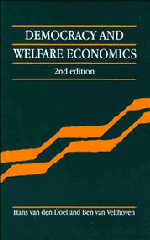4 - Majority decision
Published online by Cambridge University Press: 03 May 2011
Summary
Majority versus unanimity
Referendum democracy
In this chapter we discuss the referendum democracy, a decision-making model in which the group members make binding collective decisions without the intervention of representatives.
As an independent model such a direct democracy seldom occurs. On a national level some countries have a mandatory and decisive referendum but only with regard to changes in the constitution (like Denmark, Ireland, Austria, Spain and Australia). Liechtenstein works with a combination of voters' initiatives and plebiscites. At the initiative of at least 600 members of the electorate, proposals can be submitted to parliament; if the parliament rejects the proposal, then it is submitted to a decisive plebiscite. Although a parliamentary democracy, Switzerland comes closest to being a direct democracy. Next to a mandatory and decisive referendum with regard to changes in the constitution, the country also has a voters' initiative. If at least 50,000 voters choose to do so, laws and decisions of a general nature that passed through parliament can be submitted to a decisive citizens' vote. The population can also submit a request to change the constitution. This takes at least 100,000 of the electorate. After a parliamentary debate, a decisive referendum is held. Between 1951 and 1983 42 voters' initiatives came up in Switzerland and 116 referendums were held.
Although a referendum democracy hardly occurs as an independent model, a discussion is necessary because even in its abstract form, a referendum democracy has three elements which return in other decision-making models.
- Type
- Chapter
- Information
- Democracy and Welfare Economics , pp. 87 - 115Publisher: Cambridge University PressPrint publication year: 1993



